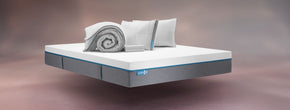How high should your bed be? A complete guide to bed height

While the height of your bed probably won’t impact your sleep, it can have an impact on how easy it is to get in and out of, depending on your life stage and mobility needs.
It also determines how much storage you can fit underneath, as a higher bed can accommodate pull-out drawers underneath, which is important if you want to maximise the space and minimise the clutter in your bedroom.
The Average / Standard bed height
In general, bed frames range between 30 - 60 cm (11 - 24 inches) in height, without a mattress. The average bed sits around 60 cm high with a mattress.
Futon style beds are the lowest, sitting on slats or directly on the floor, whereas vintage and antique beds tend to be taller than their modern counterparts.
Ottoman or divan beds tend to be taller to accommodate under bed storage, while lower bed frames have a more contemporary look.
Simba beds come in various heights to suit tastes and needs.
Our premium bed collection offers 500 different combinations from six headboard styles, four base options, and upholstered fabric finishes in six colours. Camden, Hudson, Ludlow, Wilmslow, Didsbury and Melrose all come in a standard height of 34 cm, with flexible storage capacity including drawers and an ottoman.
The Ottoman is 37 cm and our solid wood frames, Ashdown and Sherwood, are 36 cm and 38.5 cm respectively. While Simba mattresses will add a further 20 cm to 34 cm to the height of your bed.
What is the ideal bed height?
The ideal bed height is based on your height. You should be able to sit comfortably on the edge of your bed with your feet firmly on the floor, and your knees level with your hips.
If your knees are above your hips, then your bed frame could be too low. If your knees are below your hips or your feet can’t reach the floor, your bed frame is probably too high.
High bed frame vs low bed height
What are the pros and cons of a high or a low bed?
- A bed that is too low can put pressure on the joints and should be avoided by anyone elderly, infirm or with mobility issues
- Low beds are safer for toddlers, small children and parents who co-sleep with young children
- High beds with lots of storage can maximise a tight space
- Cabin beds, mid sleepers and bunk beds can be fun for kids and incorporate a desk, truckle bed, storage or play space underneath
- A low bed can fit under eaves or a sloped ceiling in a loft room or old building
- High beds can be risky for the elderly or infirm
- Low beds look more modern than high beds and tend to have a cool, minimal style
- A high / tall bed can feel very decadent
How to find the best bed height?
When shopping for a new bed it’s sensible to consider;
- Who is the bed for?
- Is there more than one occupant?
- Do I need to do more with the space than just sleep?
- Do I need additional storage?
How to raise the height of your bed
There are a handful of ways to raise the height of your bed;
- Use bed risers or your D-I-Y skills to raise your bed base. Bed risers are moveable supports in plastic, metal and wood, and sit under the legs or corners of your bed frame. Make sure you use something stable.
- Replace your mattress with a taller version. Engineered with 13 supportive and comforting boosting layers, at 34 cm the Hybrid® Ultra is our deepest model.
- Add some extra height with our Hybrid® Mattress Topper. With four additional layers of comfort-boosting technology, including a layer of 2,500 Aerocoil® springs, Simbatex® foam comfort layer and a super soft, breathable sleep surface, it can add an extra 6.5 cm to any mattress.
"The design is timeless and comfortable"- Maria J, Sherwood Bed
"Easy to put together and looks amazing"-Daniel S, Didsbury Bed














